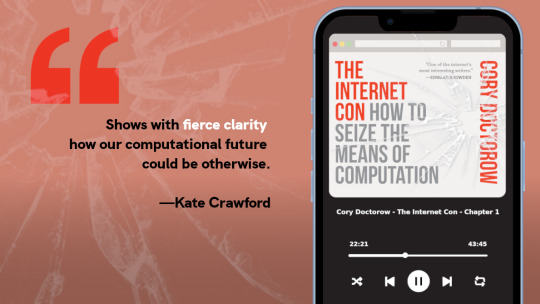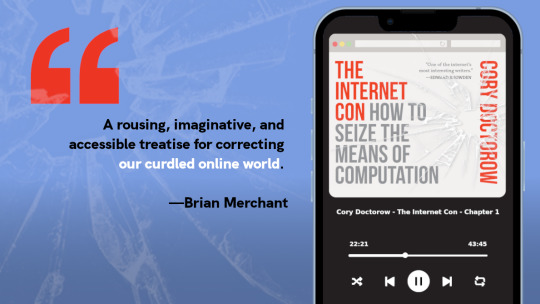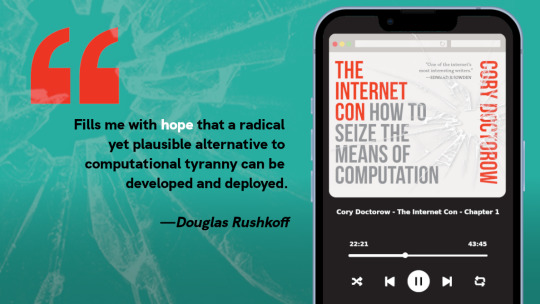#system interoperability
Explore tagged Tumblr posts
Text

Hello lightning-fast speed and farewell mistakes.
Enter the era of data magic now!
Learn more: https://vorro.net/solutions/interoperability/
#data interoperability#system interoperability#healthcare data interoperability#healthcare interoperability solutions#interoperability platform#Interoperability Solutions#data integration and interoperability
0 notes
Text
Epic Systems, a lethal health record monopolist

Epic Systems makes the dominant electronic health record (EHR) system in America; if you're a doctor, chances are you are required to use it, and for every hour a doctor spends with a patient, they have to spend two hours doing clinically useless bureaucratic data-entry on an Epic EHR.
How could a product so manifestly unfit for purpose be the absolute market leader? Simple: as Robert Kuttner describes in an excellent feature in The American Prospect, Epic may be a clinical disaster, but it's a profit-generating miracle:
https://prospect.org/health/2024-10-01-epic-dystopia/
At the core of Epic's value proposition is "upcoding," a form of billing fraud that is beloved of hospital administrators, including the "nonprofit" hospitals that generate vast fortunes that are somehow not characterized as profits. Here's a particularly egregious form of upcoding: back in 2020, the Poudre Valley Hospital in Ft Collins, CO locked all its doors except the ER entrance. Every patient entering the hospital, including those receiving absolutely routine care, was therefore processed as an "emergency."
In April 2020, Caitlin Wells Salerno – a pregnant biologist – drove to Poudre Valley with normal labor pains. She walked herself up to obstetrics, declining the offer of a wheelchair, stopping only to snap a cheeky selfie. Nevertheless, the hospital recorded her normal, uncomplicated birth as a Level 5 emergency – comparable to a major heart-attack – and whacked her with a $2755 bill for emergency care:
https://pluralistic.net/2021/10/27/crossing-a-line/#zero-fucks-given
Upcoding has its origins in the Reagan revolution, when the market-worshipping cultists he'd put in charge of health care created the "Prospective Payment System," which paid a lump sum for care. The idea was to incentivize hospitals to provide efficient care, since they could keep the difference between whatever they spent getting you better and the set PPS amount that Medicare would reimburse them. Hospitals responded by inventing upcoding: a patient with controlled, long-term coronary disease who showed up with a broken leg would get coded for the coronary condition and the cast, and the hospital would pocket both lump sums:
https://pluralistic.net/2024/06/13/a-punch-in-the-guts/#hayek-pilled
The reason hospital administrators love Epic, and pay gigantic sums for systemwide software licenses, is directly connected to the two hours that doctors spent filling in Epic forms for every hour they spend treating patients. Epic collects all that extra information in order to identify potential sources of plausible upcodes, which allows hospitals to bill patients, insurers, and Medicare through the nose for routine care. Epic can automatically recode "diabetes with no complications" from a Hierarchical Condition Category code 19 (worth $894.40) as "diabetes with kidney failure," code 18 and 136, which gooses the reimbursement to $1273.60.
Epic snitches on doctors to their bosses, giving them a dashboard to track doctors' compliance with upcoding suggestions. One of Kuttner's doctor sources says her supervisor contacts her with questions like, "That appointment was a 2. Don’t you think it might be a 3?"
Robert Kuttner is the perfect journalist to unravel the Epic scam. As a journalist who wrote for The New England Journal of Medicine, he's got an insider's knowledge of the health industry, and plenty of sources among health professionals. As he tells it, Epic is a cultlike, insular company that employs 12.500 people in its hometown of Verona, WI.
The EHR industry's origins start with a GW Bush-era law called the HITECH Act, which was later folded into Obama's Recovery Act in 2009. Obama provided $27b to hospitals that installed EHR systems. These systems had to more than track patient outcomes – they also provided the data for pay-for-performance incentives. EHRs were already trying to do something very complicated – track health outcomes – but now they were also meant to underpin a cockamamie "incentives" program that was supposed to provide a carrot to the health industry so it would stop killing people and ripping off Medicare. EHRs devolved into obscenely complex spaghetti systems that doctors and nurses loathed on sight.
But there was one group that loved EHRs: hospital administrators and the private companies offering Medicare Advantage plans (which also benefited from upcoding patients in order to soak Uncle Sucker):
https://www.ncbi.nlm.nih.gov/pmc/articles/PMC8649706/
The spread of EHRs neatly tracks with a spike in upcharging: "from 2014 through 2019, the number of hospital stays billed at the highest severity level increased almost 20 percent…the number of stays billed at each of the other severity levels decreased":
https://oig.hhs.gov/oei/reports/OEI-02-18-00380.pdf
The purpose of a system is what it does. Epic's industry-dominating EHR is great at price-gouging, but it sucks as a clinical tool – it takes 18 keystrokes just to enter a prescription:
https://jamanetwork.com/journals/jamanetworkopen/fullarticle/2729481
Doctors need to see patients, but their bosses demand that they satisfy Epic's endless red tape. Doctors now routinely stay late after work and show up hours early, just to do paperwork. It's not enough. According to another one of Kuttner's sources, doctors routinely copy-and-paste earlier entries into the current one, a practice that generates rampant errors. Some just make up random numbers to fulfill Epic's nonsensical requirements: the same source told Kuttner that when prompted to enter a pain score for his TB patients, he just enters "zero."
Don't worry, Epic has a solution: AI. They've rolled out an "ambient listening" tool that attempts to transcribe everything the doctor and patient say during an exam and then bash it into a visit report. Not only is this prone to the customary mistakes that make AI unsuited to high-stakes, error-sensitive applications, it also represents a profound misunderstanding of the purpose of clinical notes.
The very exercise of organizing your thoughts and reflections about an event – such as a medical exam – into a coherent report makes you apply rigor and perspective to events that otherwise arrive as a series of fleeting impressions and reactions. That's why blogging is such an effective practice:
https://pluralistic.net/2021/05/09/the-memex-method/
The answer to doctors not having time to reflect and organize good notes is to give them more time – not more AI. As another doctor told Kuttner: "Ambient listening is a solution to a self-created problem of requiring too much data entry by clinicians."
EHRs are one of those especially hellish public-private partnerships. Health care doctrine from Reagan to Obama insisted that the system just needed to be exposed to market forces and incentives. EHRs are designed to allow hospitals to win as many of these incentives as possible. Epic's clinical care modules do this by bombarding doctors with low-quality diagnostic suggestions with "little to do with a patient’s actual condition and risks," leading to "alert fatigue," so doctors miss the important alerts in the storm of nonsense elbow-jostling:
https://www.ncbi.nlm.nih.gov/pmc/articles/PMC5058605/
Clinicians who actually want to improve the quality of care in their facilities end up recording data manually and keying it into spreadsheets, because they can't get Epic to give them the data they need. Meanwhile, an army of high-priced consultants stand ready to give clinicians advise on getting Epic to do what they need, but can't seem to deliver.
Ironically, one of the benefits that Epic touts is its interoperability: hospitals that buy Epic systems can interconnect those with other Epic systems, and there's a large ecosystem of aftermarket add-ons that work with Epic. But Epic is a product, not a protocol, so its much-touted interop exists entirely on its terms, and at its sufferance. If Epic chooses, a doctor using its products can send files to a doctor using a rival product. But Epic can also veto that activity – and its veto extends to deciding whether a hospital can export their patient records to a competing service and get off Epic altogether.
One major selling point for Epic is its capacity to export "anonymized" data for medical research. Very large patient data-sets like Epic's are reasonably believed to contain many potential medical insights, so medical researchers are very excited at the prospect of interrogating that data.
But Epic's approach – anonymizing files containing the most sensitive information imaginable, about millions of people, and then releasing them to third parties – is a nightmare. "De-identified" data-sets are notoriously vulnerable to "re-identification" and the threat of re-identification only increases every time there's another release or breach, which can used to reveal the identities of people in anonymized records. For example, if you have a database of all the prescribing at a given hospital – a numeric identifier representing the patient, and the time and date when they saw a doctor and got a scrip. At any time in the future, a big location-data breach – say, from Uber or a transit system – can show you which people went back and forth to the hospital at the times that line up with those doctor's appointments, unmasking the person who got abortion meds, cancer meds, psychiatric meds or other sensitive prescriptions.
The fact that anonymized data can – will! – be re-identified doesn't mean we have to give up on the prospect of gleaning insight from medical records. In the UK, the eminent doctor Ben Goldacre and colleagues built an incredible effective, privacy-preserving "trusted research environment" (TRE) to operate on millions of NHS records across a decentralized system of hospitals and trusts without ever moving the data off their own servers:
https://pluralistic.net/2024/03/08/the-fire-of-orodruin/#are-we-the-baddies
The TRE is an open source, transparent server that accepts complex research questions in the form of database queries. These queries are posted to a public server for peer-review and revision, and when they're ready, the TRE sends them to each of the databases where the records are held. Those databases transmit responses to the TRE, which then publishes them. This has been unimaginably successful: the prototype of the TRE launched during the lockdown generated sixty papers in Nature in a matter of months.
Monopolies are inefficient, and Epic's outmoded and dangerous approach to research, along with the roadblocks it puts in the way of clinical excellence, epitomizes the problems with monopoly. America's health care industry is a dumpster fire from top to bottom – from Medicare Advantage to hospital cartels – and allowing Epic to dominate the EHR market has somehow, incredibly, made that system even worse.
Naturally, Kuttner finishes out his article with some antitrust analysis, sketching out how the Sherman Act could be brought to bear on Epic. Something has to be done. Epic's software is one of the many reasons that MDs are leaving the medical profession in droves.
Epic epitomizes the long-standing class war between doctors who want to take care of their patients and hospital executives who want to make a buck off of those patients.

Tor Books as just published two new, free LITTLE BROTHER stories: VIGILANT, about creepy surveillance in distance education; and SPILL, about oil pipelines and indigenous landback.


If you'd like an essay-formatted version of this post to read or share, here's a link to it on pluralistic.net, my surveillance-free, ad-free, tracker-free blog:
https://pluralistic.net/2024/10/02/upcoded-to-death/#thanks-obama

Image: Flying Logos (modified) https://commons.wikimedia.org/wiki/File:Over_$1,000,000_dollars_in_USD_$100_bill_stacks.png
CC BY-SA 4.0 https://creativecommons.org/licenses/by-sa/4.0/deed.en
#pluralistic#ehrs#robert kuttner#tres#trusted research environments#ben goldacre#epic#epic systems#interoperability#privacy#reidentification#deidentification#thanks obama#upcoding#Hierarchical Condition Category#medicare#medicaid#ai#American Recovery and Reinvestment Act#HITECH act#medicare advantage#ambient listening#alert fatigue#monopoly#antitrust
820 notes
·
View notes
Text
#IoT Testing#Internet of Things#Device Testing#Functional Testing#Performance Testing#Security Testing#Interoperability Testing#Usability Testing#Regression Testing#IoT Security#Smart Devices#Connected Systems#IoT Protocols#GQATTech#IoT Solutions#Data Privacy#System Integration#User Experience#IoT Performance#Compliance Testing#POS Testing#Point of Sale#Retail Technology#Transaction Processing#System Reliability#Customer Experience#Compatibility Testing#Retail Operations#Payment Systems#PCI DSS Compliance
0 notes
Text
HL7 Platforms Explained: The Backbone of Healthcare Communication Standards
In today's fast-changing healthcare environment, a healthcare interoperability solution is essential for seamless communication among various medical systems. Hospitals, labs, clinics, and other healthcare providers use many different software applications, devices, and data formats. Without a proper system to connect these, sharing important patient information can become slow, incomplete, or error-prone. This is where HL7 platforms come in as the foundation for making healthcare data flow smoothly and securely.
HL7 platforms are the key technology behind many healthcare interoperability solutions used worldwide. They help different healthcare systems “talk” to each other using common standards, enabling better coordination of care. In this blog, we will explain what HL7 platforms are, why they matter, and how they support modern tools like FHIR compliant interoperability software. We will also show how healthcare organizations benefit by adopting these platforms.

What is an HL7 Platform?
An HL7 platform is a software framework or tool that supports the HL7 standard for healthcare data exchange. HL7 stands for Health Level Seven, which is a set of international standards that define how health information is packaged and shared between computer systems.
These platforms act as translators and routers. They take medical data from one system, convert it into a common HL7 format, and then send it to another system that understands that format. This process allows different applications — such as electronic health records (EHRs), lab systems, and billing software — to exchange information accurately and quickly.
By using an HL7 platform, hospitals and clinics reduce the need for manual data entry, lower errors, and speed up patient care.
Why Are Healthcare Interoperability Platforms Important?
Healthcare is complex, with many stakeholders involved. Different departments and providers often use different software systems. Without a healthcare interoperability solution, these systems work in isolation, which can cause delays and miscommunication.
Healthcare interoperability platforms help solve this problem by connecting systems and enabling them to share data in real time. They improve patient safety by giving doctors access to complete medical histories, test results, and medication lists without delay. This better communication also cuts costs by avoiding duplicate tests and unnecessary procedures.
Moreover, interoperability platforms help healthcare providers meet regulatory requirements for data sharing and privacy. They build trust by ensuring patient information is exchanged securely and only with authorized parties.

How HL7 Platforms Work with FHIR Compliant Interoperability Software
In recent years, HL7 introduced a newer standard called FHIR (Fast Healthcare Interoperability Resources). FHIR simplifies healthcare data exchange by using modern web technologies such as RESTful APIs and JSON/XML formats. This makes integration faster and easier compared to older HL7 versions.
Many healthcare organizations are now adopting FHIR compliant interoperability software alongside traditional HL7 platforms. This software supports both the HL7 standards and FHIR, providing a flexible way to connect new and legacy systems.
HL7 platforms play a vital role in bridging older systems that use classic HL7 messaging with modern applications designed for FHIR. This combined approach helps healthcare providers gradually upgrade their technology without disrupting patient care.
Benefits of Using HL7 Platforms in Healthcare
Using HL7 platforms as part of a healthcare interoperability solution offers several key benefits:
1. Seamless Data Exchange
HL7 platforms ensure smooth and standardized data flow between different healthcare systems, allowing accurate and timely access to patient information.
2. Enhanced Patient Care
Better data sharing leads to improved diagnosis and treatment decisions. Clinicians have full medical histories and test results at their fingertips.
3. Cost Savings
By reducing duplicated tests and manual paperwork, HL7 platforms lower administrative costs and reduce delays in patient care.
4. Regulatory Compliance
These platforms help meet health data exchange regulations and maintain patient privacy by controlling data access and sharing.
5. Support for New Technologies
HL7 platforms work with FHIR and other modern standards, enabling healthcare providers to adopt innovative digital health tools without starting from scratch.
How Helixbeat Supports Your Healthcare Interoperability Needs
Helixbeat offers advanced healthcare interoperability platforms designed to help organizations manage and exchange health data effectively. With our expertise in FHIR compliant interoperability software, we deliver solutions that connect your existing systems and new digital tools.
Our platforms provide secure, scalable, and easy-to-use interfaces that improve collaboration across healthcare teams. Whether you are implementing HL7 messaging or transitioning to FHIR, Helixbeat’s solutions can adapt to your needs.
Contact us today to learn how Helixbeat can help your organization build a robust healthcare interoperability solution that improves patient outcomes and operational efficiency.

FAQs About HL7 Platforms and Healthcare Interoperability
1. What is the main purpose of an HL7 platform?
An HL7 platform standardizes and manages the exchange of healthcare information between different software systems to improve communication and patient care.
2. How does FHIR relate to HL7?
FHIR is a modern standard developed by HL7 that uses web technologies for faster and easier healthcare data exchange compared to older HL7 versions.
3. Why is healthcare interoperability important?
Interoperability allows different healthcare systems to share patient data efficiently, improving care quality, reducing errors, and cutting costs.
4. Can HL7 platforms work with existing hospital software?
Yes, HL7 platforms are designed to integrate with many legacy systems as well as new healthcare applications, enabling smooth data exchange.
5. How does Helixbeat support healthcare interoperability?
Helixbeat provides scalable and secure interoperability platforms, including FHIR compliant software, that connect diverse healthcare systems seamlessly.
#electronic health record systems#electronic medical records software#FHIR compliant interoperability software#healthcare interoperability platforms#hl7 platform
0 notes
Text
BIM Software Solutions for Modern HVAC Applications
As the HVAC industry continues to evolve in 2025, Building Information Modeling (BIM) has become an indispensable tool for professionals seeking to optimize design, installation, and maintenance processes. For HVAC engineers, contractors, and technicians, selecting the right BIM software can significantly impact project efficiency and outcomes. Let’s explore the most effective BIM solutions for…
#3D modeling#augmented reality#Autodesk Revit#automation#Bentley AECOsim#BIM#BIM workflows#building information modeling#Building performance#building systems#clash detection#cloud collaboration#cooling loads#decision matrix#digital twin#duct design#energy analysis#Energy efficiency#fabrication documentation#Graphisoft ArchiCAD#heating loads#hvac#HVAC design software#HVAC engineering#interoperability#mechanical engineering#mechanical systems#MEP#MEP coordination#mixed reality
0 notes
Text
Joseph Gordon Levitt: Why Tiktok should be more like Email
He wrote this wonderful article on Substack, link's below but I just had to put this quote cause its basically the TLDR.

Imo the internet is basically a bunch of gated communities.
#free our feeds#joseph gordon levitt#tiktok ban#social media#substack#email#interoperable system#content creator
0 notes
Text

Interoperable Blockchain System
Operational risks caused by inadequate internal processes or external events pose a high risk to the oil and gas industry. Talk to our experts to know how Verofax can help.
Know more: https://verofax.com/oil-and-gas
0 notes
Text
Unlocking the Future: Exploring the Wonders of KNX in Home Automation

In the realm of home automation, where technology seamlessly intertwines with our daily lives, KNX stands out as a beacon of innovation. This article will unravel the mysteries of KNX, a standardized communication protocol that has revolutionized the way we control and interact with smart devices in our homes. Let's embark on a journey to understand the essence of KNX and its transformative role in shaping the future of home automation.
What is KNX?
At its core, KNX is more than just a set of letters; it's a powerhouse in the world of home automation. KNX, which stands for Konnex, is a standardized communication protocol that enables smart devices in a home to communicate with each other. Imagine a home where lighting, heating, security systems, and more work together seamlessly. That's the magic of KNX.
Advantages of Using KNX
The beauty of KNX lies in its versatility and compatibility. Unlike proprietary systems, KNX is an open standard, allowing devices from different manufacturers to communicate effortlessly. This interoperability ensures that your smart home system can evolve and expand without being confined to a specific brand or technology.
Components of a KNX System
To understand KNX fully, we need to peek behind the curtain. KNX systems consist of actuators and sensors, forming the backbone of the smart home. The KNX bus system facilitates communication between devices, while programming tools and software provide users with the flexibility to customize their automation setup.
The Role of KNX in Home Automation
Imagine arriving home, and the lights automatically adjust to your preferred ambiance, the thermostat adjusts to the perfect temperature, and your security system is armed—all triggered by a single command. KNX makes this scenario a reality, offering a centralized and streamlined control hub for various aspects of home automation.
Installation and Setup
While the wonders of KNX are vast, the installation process is surprisingly straightforward. Professional installation ensures optimal performance, and once set up, users can easily configure and adapt their smart home to suit their changing needs.
KNX vs. Other Home Automation Protocols
In a world of competing protocols like Zigbee and Z-Wave, KNX holds its ground. Its unique features, including wired communication and broader compatibility, make it a standout choice for those seeking a reliable and scalable home automation solution.
Applications of KNX in Different Settings
KNX isn't limited to residential spaces. Its adaptability extends to commercial and industrial settings, where precise control and automation play a crucial role in enhancing efficiency and reducing energy consumption.
Challenges and Solutions in Implementing KNX
While the benefits of KNX are evident, users may encounter challenges during implementation. This section will guide you through common hurdles and provide strategies to overcome them, ensuring a smooth transition to a KNX-powered home.
KNX and the Future of Home Automation
The journey doesn't end here. The future holds exciting prospects for KNX, with ongoing developments and emerging trends promising to elevate home automation to new heights. Stay tuned as we explore what's on the horizon for this innovative technology.
User Experiences with KNX
Real-world stories often speak louder than technical specifications. Discover how individuals and businesses have transformed their spaces with KNX, turning their homes and offices into intelligent, responsive environments.
Cost Considerations for KNX Systems
Investing in a KNX system may raise questions about costs. This section will break down the initial investment and highlight the long-term benefits, showcasing why KNX is a worthwhile investment for homeowners and businesses alike.
Security and Privacy Concerns with KNX
As with any connected system, security and privacy are paramount. Learn about the measures in place to address potential risks, ensuring that your KNX-powered home is secure and your privacy is protected.
KNX Certification and Standards
To guarantee the reliability of your KNX system, certification is key. This section explores the importance of KNX certification and the adherence to industry standards, providing peace of mind for users.
Conclusion
In conclusion, KNX is the key to unlocking the full potential of home automation. Its open standard, interoperability, and adaptability make it a frontrunner in the race to create smart, connected homes. As technology continues to evolve, embracing KNX opens doors to a future where our living spaces are not just smart but truly intelligent.
FAQs
Is KNX only for residential use?
No, KNX is versatile and finds applications in both residential and commercial settings, offering tailored solutions for diverse needs.
How often do KNX systems need updates?
Updates depend on technological advancements and individual preferences. However, KNX systems are designed to be future-proof, minimizing the need for frequent updates.
Can I integrate non-KNX devices into a KNX system?
KNX's open standard allows integration with devices from different manufacturers,
#In the realm of home automation#What is KNX?#At its core#which stands for Konnex#heating#security systems#Advantages of Using KNX#KNX is an open standard#Components of a KNX System#To understand KNX fully#Imagine arriving home#Installation and Setup#and once set up#Applications of KNX in Different Settings#User Experiences with KNX#responsive environments.#As with any connected system#KNX Certification and Standards#interoperability#Is KNX only for residential use?
0 notes
Text




The Army Artillery Regiment (AAR), Army Aviation Regiment (AAvnR) and Special Forces Regiment (Airborne) SFR(A) recently conducted their first Interoperability Exercise (IOX) in Nueva Ecija, which included the live-firing of the Philippine Army’s (PA) newest Artillery Asset, the Autonomous Truck MOunted-howitzer System (ATMOS)
SOURCES:
Army Artillery "King of Battle" Regiment, Philippine Army Facebook Page Post, 09/23/23 – 1119H {Archived Link}
Army Artillery "King of Battle" Regiment, Philippine Army Facebook Page Post, 09/22/23 – 2105H {Archived Link}
Check out the Links to my other Social Media Accounts at https://linktr.ee/rhk111
If you like my Work, buy me a Coffee to help support it at https://www.buymeacoffee.com/rhk111
#philippine army pa#army artillery regiment aar#army aviation regiment aavnr#special forces regiment airborne sfra#nueva ecija#interoperability exercise iox#autonomous truck mounted howitzer system atmos
0 notes
Note
I might be asking the wrong person here, but why is the Acela so expensive? I need to travel from Boston to DC for a week for work so I compared costs and convenience of driving, flying, and taking the Acela and was surprised to find that the Acela costs more than flying (I was able to find round trip flights BOS-DCA for about $170, the Acela starts at about $140 each way) despite being significantly slower. Why does it cost so much?
I will concede that the Northeast Regional is cheaper than flying (about $60 each way), but it's also even slower than the Acela.
The Acela has several problems compared to analogous systems in other countries, and as a business problems mean costs and costs means prices.
Making a direct comparison to air travel also requires talking a little bit about the economics of air travel, since there are surprising number of weird things about that business compared to rail.
Part 1. Amtrak doesn’t own most of its own tracks. While it does own most of the North East Corridor, it leases track rights for the boston-providence leg from ME MOTHERFUCKER I’M THE PROBLEM and also the states of NY and CT own a section between NYC and New Haven. Now, when you are trying to have trains at up to 160mph, you need maintenance to be done within extremely tight tolerances, you need signaling to be extremely precise and consistent, and small mistakes can be deadly. Signaling and Maintenance on rented tracks are not literally impossible but they are a huge pain in the ass. These sections are slower and make the whole network much more expensive.
Part Two! Electification: this is one of the oldest rail corridors in the world and that means there’s a lot of old DNA in the network that it would not have if there was a full rebuild. One of these design “features” is that when the line was built, electricity wasn’t standardized and different plants would churn out different voltages and AC frequencies.
Between NYC and Washington there is a catenary system that operates at 11kv, 25hz that was built in 1905. This is insane. The modern grid runs at 60hz, and transforming power from a modern plant into 11kv, 25hz is a huge project in and of itself. But of course, the Boston to Providence section, electrified in 1990, has only the most cutting edge technology. It’s electrified with 60hz, 12.5kv, 10 years ahead of its time which was 35 years ago. And, when the Acela was first planned and operated in 2000, it was planned and operated with the now modern standard of 60hz, 25kv. So there are three different electrification systems and, to not have to switch trains, each train needs to be able to run with all 3 of them.
This is deeply stupid and only something you would have to deal with if you were hacking together increasingly expensive short term repairs onto a system that would be cheaper in 20-50 years to completely overhaul but in the present would cost 10s of billions to meaningfully bring up to 20th century operating standards. It’s a good thing we did the smart thing in the 1970s when Amtrak nationalized the collapsing private passenger rail companies and Conrail nationalized the collapsing freight rail companies and we recognized that running these crucial services with public money could generate huge amounts of economic activity and benefit society even if they ran at a fiscal loss, and properly funded the systems to build reliable and interoperable infrastructure for the next generation. Hold on I have to take this phone call.
………….
Yep.
…………..
Yeah ok.
…………..
They did WHAT?
Part Three: Ronald reagan is not dead enough
So yeah the main reason that none of this shit got fixed in the last 50 years is that for 4 successive administrations between Reagan and Bush 2 electric boogaloo the government has been slobbing on that Neoliberal knob like its subsidized corn on a subsidized cob. Private operators immediately saw the potential for infinitely lucrative federal contracts when the US seized the assets of Erie Lackawanna and Penn Central during their bankruptcy and formed Conrail. This was mainly Norfolk southern and CSX, former competitors who pushed hard for the reagan, bush, and clinton organizations to refurbish the lines at taxpayer expense before selling them to absolute corporate bottomfeeders so they could snap up lines that had been the main sources of revenue for these defunct companies at kleptocratic rates. But we’re not done. Freight companies hate two things more than even paying taxes, and these are OSHA and Passenger rail.
You see, it’s actually very hard to run freight and passenger on the same tracks. Freight is slow with long trains, long sidings, and loose schedules. Freight is optimized to get there, you know, sometime as cheap as possible. However, if you have passenger rail, those people have places to be. They need things like advanced signaling to move faster than 15 miles an hour, sidings long enough to pass at speed, and even, gasp, rails that don’t have holes in them so they don’t derail on corners. It’s not hard for a freight train to move along a track that is 85% rust, they just go slow and if they derail you’re only looking at maybe 2 superfund sites. But passenger rail, there will be bumps and passengers will complain. Customers are so unreasonable.
So when the federal government acquired all the tracks that became conrail, what did they do? Cut sidings, cut double tracks down to single tracks, cut maintenance, sold land. None of these bothered their future freight owner-operators. But they did undermine American passenger rail, on purpose, for 50 years. As soon as the work was done, the tracks were unfit for anything other than 400 box trucks of nitroglycerin pulled by two locomotives with one operator. How do you run passenger rail on that? Well, you play by CSX and Norfolk Bastard’s rules. Fuck your schedule. Fuck it slow. Fuck it for so long that it hurts. And, when you’ve bled enough revenue, complain to the federal government that you can’t possibly keep going and need to be sold off to private equity for parts.
So yeah. Freight rail in the 70s, the ruthless march of neoliberal capitalism, a frankenstein’s monster of a network, and a complete lack of revenue from either public subsidy or ridership to fix either problem.
Oh and there’s the fact that every single Major airline operates their flights at a loss and use credit cards as their primary source of income. The scheme is you take out a credit card, they run like a normal credit card company, except whereas most banks give you cash back they give you “miles” or “points” the vast majority of which will never get spent. It’s almost a license to print money as long as you have enough people you can convince will someday be able to afford to go on vacation with that fancy credit card they paid for. Budget Airlines who don’t run this scheme are folding both in the sense that they are going under financially and also in the sense that you better hope that your spine lets you compress into the overhead compartment if you want to get to your destination.
66 notes
·
View notes
Text
Kickstarting a book to end enshittification, because Amazon will not carry it

My next book is The Internet Con: How to Seize the Means of Computation: it’s a Big Tech disassembly manual that explains how to disenshittify the web and bring back the old good internet. The hardcover comes from Verso on Sept 5, but the audiobook comes from me — because Amazon refuses to sell my audio:
https://www.kickstarter.com/projects/doctorow/the-internet-con-how-to-seize-the-means-of-computation
Amazon owns Audible, the monopoly audiobook platform that controls >90% of the audio market. They require mandatory DRM for every book sold, locking those books forever to Amazon’s monopoly platform. If you break up with Amazon, you have to throw away your entire audiobook library.
That’s a hell of a lot of leverage to hand to any company, let alone a rapacious monopoly that ran a program targeting small publishers called “Project Gazelle,” where execs were ordered to attack indie publishers “the way a cheetah would pursue a sickly gazelle”:
https://www.businessinsider.com/sadistic-amazon-treated-book-sellers-the-way-a-cheetah-would-pursue-a-sickly-gazelle-2013-10

[Image ID: Journalist and novelist Doctorow (Red Team Blues) details a plan for how to break up Big Tech in this impassioned and perceptive manifesto….Doctorow’s sense of urgency is contagious -Publishers Weekly]
I won’t sell my work with DRM, because DRM is key to the enshittification of the internet. Enshittification is why the old, good internet died and became “five giant websites filled with screenshots of the other four” (h/t Tom Eastman). When a tech company can lock in its users and suppliers, it can drain value from both sides, using DRM and other lock-in gimmicks to keep their business even as they grow ever more miserable on the platform.
Here is how platforms die: first, they are good to their users; then they abuse their users to make things better for their business customers; finally, they abuse those business customers to claw back all the value for themselves. Then, they die:
https://pluralistic.net/2023/01/21/potemkin-ai/#hey-guys

[Image ID: A brilliant barn burner of a book. Cory is one of the sharpest tech critics, and he shows with fierce clarity how our computational future could be otherwise -Kate Crawford, author of The Atlas of AI”]
The Internet Con isn’t just an analysis of where enshittification comes from: it’s a detailed, shovel-ready policy prescription for halting enshittification, throwing it into reverse and bringing back the old, good internet.
How do we do that? With interoperability: the ability to plug new technology into those crapulent, decaying platform. Interop lets you choose which parts of the service you want and block the parts you don’t (think of how an adblocker lets you take the take-it-or-leave “offer” from a website and reply with “How about nah?”):
https://www.eff.org/deeplinks/2019/07/adblocking-how-about-nah
But interop isn’t just about making platforms less terrible — it’s an explosive charge that demolishes walled gardens. With interop, you can leave a social media service, but keep talking to the people who stay. With interop, you can leave your mobile platform, but bring your apps and media with you to a rival’s service. With interop, you can break up with Amazon, and still keep your audiobooks.
So, if interop is so great, why isn’t it everywhere?
Well, it used to be. Interop is how Microsoft became the dominant operating system:
https://www.eff.org/deeplinks/2019/06/adversarial-interoperability-reviving-elegant-weapon-more-civilized-age-slay

[Image ID: Nobody gets the internet-both the nuts and bolts that make it hum and the laws that shaped it into the mess it is-quite like Cory, and no one’s better qualified to deliver us a user manual for fixing it. That’s The Internet Con: a rousing, imaginative, and accessible treatise for correcting our curdled online world. If you care about the internet, get ready to dedicate yourself to making interoperability a reality. -Brian Merchant, author of Blood in the Machine]
It’s how Apple saved itself from Microsoft’s vicious campaign to destroy it:
https://www.eff.org/deeplinks/2019/06/adversarial-interoperability-reviving-elegant-weapon-more-civilized-age-slay
Every tech giant used interop to grow, and then every tech giant promptly turned around and attacked interoperators. Every pirate wants to be an admiral. When Big Tech did it, that was progress; when you do it back to Big Tech, that’s piracy. The tech giants used their monopoly power to make interop without permission illegal, creating a kind of “felony contempt of business model” (h/t Jay Freeman).
The Internet Con describes how this came to pass, but, more importantly, it tells us how to fix it. It lays out how we can combine different kinds of interop requirements (like the EU’s Digital Markets Act and Massachusetts’s Right to Repair law) with protections for reverse-engineering and other guerrilla tactics to create a system that is strong without being brittle, hard to cheat on and easy to enforce.
What’s more, this book explains how to get these policies: what existing legislative, regulatory and judicial powers can be invoked to make them a reality. Because we are living through the Great Enshittification, and crises erupt every ten seconds, and when those crises occur, the “good ideas lying around” can move from the fringes to the center in an eyeblink:
https://pluralistic.net/2023/06/12/only-a-crisis/#lets-gooooo

[Image ID: Thoughtfully written and patiently presented, The Internet Con explains how the promise of a free and open internet was lost to predatory business practices and the rush to commodify every aspect of our lives. An essential read for anyone that wants to understand how we lost control of our digital spaces and infrastructure to Silicon Valley’s tech giants, and how we can start fighting to get it back. -Tim Maughan, author of INFINITE DETAIL]
After all, we’ve known Big Tech was rotten for years, but we had no idea what to do about it. Every time a Big Tech colossus did something ghastly to millions or billions of people, we tried to fix the tech company. There’s no fixing the tech companies. They need to burn. The way to make users safe from Big Tech predators isn’t to make those predators behave better — it’s to evacuate those users:
https://pluralistic.net/2023/07/18/urban-wildlife-interface/#combustible-walled-gardens
I’ve been campaigning for human rights in the digital world for more than 20 years; I’ve been EFF’s European Director, representing the public interest at the EU, the UN, Westminster, Ottawa and DC. This is the subject I’ve devoted my life to, and I live my principles. I won’t let my books be sold with DRM, which means that Audible won’t carry my audiobooks. My agent tells me that this decision has cost me enough money to pay off my mortgage and put my kid through college. That’s a price I’m willing to pay if it means that my books aren’t enshittification bait.
But not selling on Audible has another cost, one that’s more important to me: a lot of readers prefer audiobooks and 9 out of 10 of those readers start and end their searches on Audible. When they don’t find an author there, they assume no audiobook exists, period. It got so bad I put up an audiobook on Amazon — me, reading an essay, explaining how Audible rips off writers and readers. It’s called “Why None of My Audiobooks Are For Sale on Audible”:
https://pluralistic.net/2022/07/25/can-you-hear-me-now/#acx-ripoff

[Image ID: Doctorow has been thinking longer and smarter than anyone else I know about how we create and exchange value in a digital age. -Douglas Rushkoff, author of Present Shock]
To get my audiobooks into readers’ ears, I pre-sell them on Kickstarter. This has been wildly successful, both financially and as a means of getting other prominent authors to break up with Amazon and use crowdfunding to fill the gap. Writers like Brandon Sanderson are doing heroic work, smashing Amazon’s monopoly:
https://www.brandonsanderson.com/guest-editorial-cory-doctorow-is-a-bestselling-author-but-audible-wont-carry-his-audiobooks/
And to be frank, I love audiobooks, too. I swim every day as physio for a chronic pain condition, and I listen to 2–3 books/month on my underwater MP3 player, disappearing into an imaginary world as I scull back and forth in my public pool. I’m able to get those audiobooks on my MP3 player thanks to Libro.fm, a DRM-free store that supports indie booksellers all over the world:
https://blog.libro.fm/a-qa-with-mark-pearson-libro-fm-ceo-and-co-founder/
Producing my own audiobooks has been a dream. Working with Skyboat Media, I’ve gotten narrators like @wilwheaton, Amber Benson, @neil-gaiman and Stefan Rudnicki for my work:
https://craphound.com/shop/

[Image ID: “This book is the instruction manual Big Tech doesn’t want you to read. It deconstructs their crummy products, undemocratic business models, rigged legal regimes, and lies. Crack this book and help build something better. -Astra Taylor, author of Democracy May Not Exist, but We’ll Miss It When Its Gone”]
But for this title, I decided that I would read it myself. After all, I’ve been podcasting since 2006, reading my own work aloud every week or so, even as I traveled the world and gave thousands of speeches about the subject of this book. I was excited (and a little trepedatious) at the prospect, but how could I pass up a chance to work with director Gabrielle de Cuir, who has directed everyone from Anne Hathaway to LeVar Burton to Eric Idle?
Reader, I fucking nailed it. I went back to those daily recordings fully prepared to hate them, but they were good — even great (especially after my engineer John Taylor Williams mastered them). Listen for yourself!
https://archive.org/details/cory_doctorow_internet_con_chapter_01
I hope you’ll consider backing this Kickstarter. If you’ve ever read my free, open access, CC-licensed blog posts and novels, or listened to my podcasts, or come to one of my talks and wished there was a way to say thank you, this is it. These crowdfunders make my DRM-free publishing program viable, even as audiobooks grow more central to a writer’s income and even as a single company takes over nearly the entire audiobook market.
Backers can choose from the DRM-free audiobook, DRM-free ebook (EPUB and MOBI) and a hardcover — including a signed, personalized option, fulfilled through the great LA indie bookstore Book Soup:
https://www.kickstarter.com/projects/doctorow/the-internet-con-how-to-seize-the-means-of-computation
What’s more, these ebooks and audiobooks are unlike any you’ll get anywhere else because they are sold without any terms of service or license agreements. As has been the case since time immemorial, when you buy these books, they’re yours, and you are allowed to do anything with them that copyright law permits — give them away, lend them to friends, or simply read them with any technology you choose.
As with my previous Kickstarters, backers can get their audiobooks delivered with an app (from libro.fm) or as a folder of MP3s. That helps people who struggle with “sideloading,” a process that Apple and Google have made progressively harder, even as they force audiobook and ebook sellers to hand over a 30% app tax on every dollar they make:
https://www.kickstarter.com/projects/doctorow/red-team-blues-another-audiobook-that-amazon-wont-sell/posts/3788112
Enshittification is rotting every layer of the tech stack: mobile, payments, hosting, social, delivery, playback. Every tech company is pulling the rug out from under us, using the chokepoints they built between audiences and speakers, artists and fans, to pick all of our pockets.
The Internet Con isn’t just a lament for the internet we lost — it’s a plan to get it back. I hope you’ll get a copy and share it with the people you love, even as the tech platforms choke off your communities to pad their quarterly numbers.

Next weekend (Aug 4-6), I'll be in Austin for Armadillocon, a science fiction convention, where I'm the Guest of Honor:
https://armadillocon.org/d45/

If you'd like an essay-formatted version of this thread to read or share, here's a link to it on pluralistic.net, my surveillance-free, ad-free, tracker-free blog:
https://pluralistic.net/2023/07/31/seize-the-means-of-computation/#the-internet-con

[Image ID: My forthcoming book 'The Internet Con: How to Seize the Means of Computation' in various editions: Verso hardcover, audiobook displayed on a phone, and ebook displayed on an e-ink reader.]
#pluralistic#trustbusting#big tech#gift guide#kickstarter#the internet con#books#audiobooks#enshitiffication#disenshittification#crowdfunders#seize the means of computation#audible#amazon#verso
15K notes
·
View notes
Text
A German military assessment exposes major issues with NATO weapons in Ukraine. The PzH 2000 howitzer, while advanced, is so technically fragile that its combat usefulness is in doubt. The Leopard 1A5 tank is used mostly as makeshift artillery due to weak armor. The Leopard 2A6 is too expensive and complex to maintain at the front. Air defense systems also face problems. The IRIS-T works well, but ammo is too costly and scarce. The Patriot system is called “unsuitable for combat” because its MAN carrier vehicles are outdated and lack spare parts. This information was revealed in a transcript of a lecture given by the deputy military attaché of the German embassy in Kiev. The summary of the paper is very clear: “Hardly any large German piece of equipment is fully suitable for war.”
The report cites “an internal paper of the Bundeswehr” about the real practicality of Germany’s top weapons. We can assume that the very same results extend to the entire constellation of NATO weaponry in general, since they are virtually all constructed with the same design philosophies, often even with interoperable systems—like the 120mm Rheinmetall tank barrels shared between the Abrams and Leopard series.
Also, for the sake of thoroughness and to establish context, Spiegel explains that the ‘report’ was taken from a lecture given to junior officers of the Bundeswehr by a ‘deputy military attaché of the German embassy in Kiev’:
The paper, which is available to SPIEGEL, is a transcript of a lecture given to around 200 junior officers of the German Armed Forces in Delitzsch, Saxony. The speaker was the deputy military attaché of the German embassy in Kyiv, who spoke at the end of January about the experiences of the Ukrainian armed forces in the fight against the Russian war of aggression. He spoke in clear terms about the problems the Ukrainians had with German weapons in combat. An army officer eagerly took notes in order to use the findings for training in the Bundeswehr.
Spiegel minces no words when they declare that the attaché’s report is in large part “devastating”.
40 notes
·
View notes
Text
How I Made Patient Data Access Instant with the Right Electronic Medical Records Software
Managing a clinic is not easy. Between treating patients, handling billing, and keeping up with paperwork, it can feel overwhelming. One of my biggest struggles was finding patient records quickly. Searching through files or switching between systems took a lot of time. I wanted a better way to manage everything. That’s when I found the right **electronic medical records software** and it completely changed how my clinic worked.
The Problem with Paper Records and Outdated Systems
Before using electronic medical records software, we used a mix of paper files and an old computer system. It was messy. Sometimes, files would be in the wrong place. Other times, the system would crash or take too long to load, causing delays and making patients wait longer.
It wasn’t just about being slow. Having to dig through files also meant we missed small but important details in a patient’s history. These delays affected our workflow and sometimes made patients feel we weren’t well organized.
Choosing the Right Software for My Clinic
I knew I needed a better system. But I didn’t want something complicated or expensive. I needed something:
Easy for my team to use
Fast when searching for patient data
Safe and secure for storing personal information
Affordable for a small clinic like mine
That’s when I started looking into modern electronic medical records software. After trying a few options, I found one that was just right.
How the Software Improved Patient Data Access
Once we set up the new software, the changes were clear from day one.
Simple Dashboard for Quick Search
The dashboard made it very easy to find patient records. We could search by name, phone number, or date of birth and get results in seconds. No more flipping through papers or waiting for slow systems.
Updated Patient Info in One Click
Whenever a patient visited, we could quickly check their past appointments, prescriptions, test results, and notes. Everything was available in one place.
Easy to Share Within the Clinic
If I was busy with another patient, my assistant could access the same records without delay. Everyone was on the same page, and this helped the entire team work better.
Extra Features That Helped
The electronic medical records software came with other features that made our daily work smoother:
Automatic appointment reminders for patients
Online billing and easy payment tracking
Space to upload reports, x-rays, and notes
Backup options so we never lost data
All these features saved us time and reduced stress for both staff and patients.
My Patients Noticed the Difference
Patients started commenting on how smooth their visits felt. They didn’t have to repeat information. Follow-ups were faster. Reports were ready when they arrived. They felt more cared for—and that’s what really mattered.
Conclusion
Making the switch to electronic medical records software was one of the best decisions I made for my clinic. It saved time, improved patient care, and helped my team stay more organized. If you’re running a clinic or practice and are still using paper files or an outdated system, now is the right time to consider a better solution.
Call to Action
Are you tired of digging through files and wasting time on old systems? Try switching to electronic medical records software and see how fast and simple your clinic can become. It’s a step that helps both your team and your patients every day.
#electronic health record systems#fast healthcare interoperability resources#electronic medical records software
0 notes
Text
In commemoration of my very (sur)real adventure to get back to Berlin at night via public transport, in the company of two Finnish fellow guest professors, complete with multiple side-quests and setbacks, here's a little amusing John and Scott thing. Absolutely nothing hurts.
Many thanks to @janetm74 , as ever!
ODYSSEY
It was a truth universally acknowledged that only part of Scott was born on his birthday. The other one arrived as Virgil came to be, making a complete whole.
It was a lesser known fact that Scott and John had their strengths and competences that, while quite far removed in range, complimented each other, so together they formed a formidable unit. For example, John spoke impeccable German. Scott's German was a torturous tangled mess of mixed articles and cases, but was heavily reinforced by a smile and dimples that could charm the socks off a wooden fence. Together they were typically unstoppable on a trip.
None of those interoperable skills were of any use to them at the moment, in the middle of nowhere, Berlin Metropolitan area, approaching midnight. They had one jacket between them, Scott's, which John was currently wearing. Realistically he understood Scott wasn't actually "all good, Johnny, you know I run hot!", but the piercing chill left only the little brother portion of John's brain operational. Nobody could have forseen the German public transport system pulling a kafkaesque trick and sending them on a roundabout commute around Berlin across three to four connection rides by multiple transportation types. Reaching just ever so close but never enough to actually make it to their hotel.
Throwing the vast (one might say - unlimited) supply of money at the problem of getting back to the city from John's guest lecture was also impeded by an unexpected curveball - this late and this far away from the city limits translated into cash only services. Which they hadn't carried on them since about high-school. Their state-of-the-art comms were also rendered useless by the indomitable fact of there simply being no coverage.
Scott suggested walking or hitchhiking, which earned him an unimpressed turquoise glare - John opted out of Rescue Scouts at a tender age of six for a reason, thank you very much! The aforementioned dimples would have probably scored them a ride quite swiftly, but the plan wasn't without its demerits. The most prominent of those being killed by Kayo if she ever found out.
Despite the unfortunate circumstances that were bringing them no closer to the warm and comfortable suite in the Intercontinental, John was glad to be with Scott in this. He always secretly cherished big brother attending his academic talks, the buzz of the crowd fading away in the calming, centering presence. Biggest brother was also in possession of an ability to exhude undefeatable optimism and energetic attitude that, John suspected, he'd cracked up quite a bit for his sake, despite the cold and exhaustion. John felt safe and secure in the notion they would make it home soon no matter what. Scout's honor! Safe enough he actually dozed off on the denim clad shoulder on what was, hopefully, to be the last leg of their ardorous journey by U-bahn, that time.
The unexpected problem arrived as they actually walked the length of the street to the hotel. Of course it did! Intercontinental boasted the security levels vetted by multiple international intelligence agencies. By a strike of cosmic irony, those measures were tweaked up ever so more, because The Scott Tracy and his brother were staying over the week. Which meant a full lockdown past midnight. John audibly groaned. Scott burst into a laugh that was at least part hysteria.
That time it was nothing left for them to do but test the glorified security measures and do a field upgrade of their parcour and scaling skills. The security of Intercontinental foreseeably didn't hold up against two freezing, tired, and hungry Tracies on a mission, but at least, Kayo would have the hotel staff's heads, not theirs.
#thunderbirds are go#scott tracy#scott tracy is a good big brother#john tracy#john tracy is a good brother#john tracy didn't sign up for this#my fic#thunderbirds 2015
36 notes
·
View notes
Text
Multiple current and former government IT sources tell WIRED that it would be easy to connect the IRS’s Palantir system with the ICE system at DHS, allowing users to query data from both systems simultaneously. A system like the one being created at the IRS with Palantir could enable near-instantaneous access to tax information for use by DHS and immigration enforcement. It could also be leveraged to share and query data from different agencies as well, including immigration data from DHS. Other DHS sub-agencies, like USCIS, use Databricks software to organize and search its data, but these could be connected to outside Foundry instances simply as well, experts say. Last month, Palantir and Databricks struck a deal making the two software platforms more interoperable.
“I think it's hard to overstate what a significant departure this is and the reshaping of longstanding norms and expectations that people have about what the government does with their data,” says Elizabeth Laird, director of equity in civic technology at the Center for Democracy and Technology, who noted that agencies trying to match different datasets can also lead to errors. “You have false positives and you have false negatives. But in this case, you know, a false positive where you're saying someone should be targeted for deportation.”
Mistakes in the context of immigration can have devastating consequences: In March, authorities arrested and deported Kilmar Abrego Garcia, a Salvadoran national, due to, the Trump administration says, “an administrative error.” Still, the administration has refused to bring Abrego Garcia back, defying a Supreme Court ruling.
“The ultimate concern is a panopticon of a single federal database with everything that the government knows about every single person in this country,” Venzke says. “What we are seeing is likely the first step in creating that centralized dossier on everyone in this country.”
DOGE Is Building a Master Database to Surveil and Track Immigrants
21 notes
·
View notes
Text
I think that our civilization doesn't give enough credit to things that are stackable. If you're anything like me, and the court has taken specific actions to ensure that my particular contagion cannot spread, then you currently possess stuff thrown all over hither and yon. That's French for "on the fucking floor."
Most of this is simply because things like to be on the floor. Gravity pulls them there. Who am I to fight the whims of the universe, right? Another reason this happens is that many desirable things in life are not easy to stack.
If you look at your shelves right now, you will notice that there is tons of unused vertical space above many of your favourite objects. You could fit more stuff in those shelves, easy, if only you could pile them safely on top of each other. Sure, we've all done a precarious wedge-and-hope from time to time, but it always results in something expensive or irreplaceable taking a penguin slide to the floor anyway.
Society has designed a lot of little moulded-plastic "organizers" which are meant to help with this. The idea is that you will buy into their system, which is meant to all interoperate with each other, and then all of your things will go neatly into the boxes that you have purchased, which themselves are stacked neatly on the shelves. Your parole officer will be impressed. Don't be fooled by this fool's gold of a dream. None of your shit fits in those bins, and even if it did, you won't be able to agree on an organizational scheme.
So, is there a solution to this problem? Yes: it's called velcro. All you need to do is glue a bunch of velcro strips to the top and bottom of your favourite things, and then you can just stick them together. Nothing will fall out, because it's all held in place by the space-age miracle of the hook-and-loop fastener.
Sure, it makes an ungodly noise when you remove them from the stack, and the 3M Corporation will soon be trying to put poison into my morning coffee over having misused their trademark, but it's the only way to go. Now if you'll excuse me, I need to go figure out why all my computers keep dying from static electricity.
265 notes
·
View notes